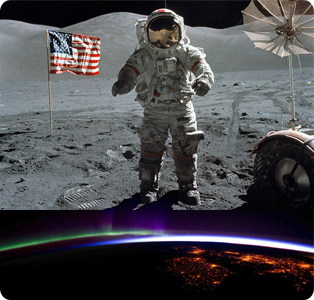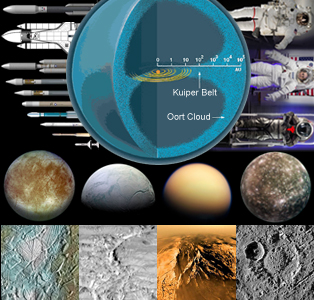Reclaiming Human Presence on Moon; The Greatest Advance in USA / Human History
Human missions to the Moon for a sustainable, international and commercial presence on our closest celestial neighbor should be of high priority for the new 2017 USA administration. The technology and resources to achieve a permanently crewed lunar research station exist today. The justifications are valid, from science and education to innovation and economics, to the very survival of our civilization. Various experts have consistently projected that 2-4 astronauts could be on the Moon’s surface within 5-7 years for about US$10B. Spaceweek 2016 marks 47th observation of Apollo 11 and 1st Humans on Moon, as well as 40th observation of Viking 1 and 1st robotic landing on another planet. NASA Solar System Exploration Research Virtual Institute at Ames Research Center in Moffett Field CA is hosting the 3rd International Conference on the Exploration of Phobos and Deimos July 18-19 and the 8th Lunar & Small Bodies Graduate Conference Jul 19 ahead of the Exploration Science Forum (ESF 2016) Jul 20-22. Another ESF-adjacent event is the Lunar Commercialization Workshop (Moon Village) at Rainbow Mansion in Cupertino Jul 19. WayPaver Foundation is launching their 2017 granting program to foster sustainable Lunar Development at an event in nearby Palo Alto Jul 20. Kennedy Space Center Apollo 11 Anniversary Gala on Jul 23 features legendary Moon-walker Buzz Aldrin and other special guests. (Image Credit: NASA) |
MONDAY
|

![]() = All times
= All times
for terrestrial events in local time unless noted.
![]() = All times for international terrestrial events in local time unless noted.
= All times for international terrestrial events in local time unless noted.
![]() = All times for space events, and…
= All times for space events, and…
![]() = All times for international space / astro events in Hawaii Standard Time unless noted. Add 10 hours to obtain UT (‘Universal Time;’ Greenwich, England).
= All times for international space / astro events in Hawaii Standard Time unless noted. Add 10 hours to obtain UT (‘Universal Time;’ Greenwich, England).
Weekly Planet Watch – Evening Planets: Mercury (WNW), Venus (WNW), Mars (SW), Jupiter (W), Saturn (S); Morning Planets: Uranus (SE), Neptune (S).
Jupiter, Saturn, Solar System Complete: Human Exploration Missions in the 21st Century
|
Continued from…
|
![]() Jun 27 – Aug 5 — Mavericks Lab, NASA, SETI, Moffett Field CA: Mavericks Lab Applied Research Accelerator: Asteroid Grand Challenge.
Jun 27 – Aug 5 — Mavericks Lab, NASA, SETI, Moffett Field CA: Mavericks Lab Applied Research Accelerator: Asteroid Grand Challenge.
![]() Jul 12-19 — NASA, Kilauea Volcano & Mauna Loa HI: 2016 NASA Planetary Volcanology Workshop; to study volcanic features analogous to those on Mars recently imaged by Mars orbiters, landers, instruments.
Jul 12-19 — NASA, Kilauea Volcano & Mauna Loa HI: 2016 NASA Planetary Volcanology Workshop; to study volcanic features analogous to those on Mars recently imaged by Mars orbiters, landers, instruments.
![]() Jul 12 – Sep 1 — International Space University, Technion Institute, Israel Space Agency, Haifa, Israel: ISU 29th Space Studies Program (SSP 2016).
Jul 12 – Sep 1 — International Space University, Technion Institute, Israel Space Agency, Haifa, Israel: ISU 29th Space Studies Program (SSP 2016).
![]() Jul 17-27 — Institute of Astrophysics and Space Sciences (IA), University of Porto, Azores Islands, Portugal: 4th Azores International Advanced School: Asteroseismology and Exoplanets – Listening to the Stars and Searching for New Worlds.
Jul 17-27 — Institute of Astrophysics and Space Sciences (IA), University of Porto, Azores Islands, Portugal: 4th Azores International Advanced School: Asteroseismology and Exoplanets – Listening to the Stars and Searching for New Worlds.
TUESDAY
![]() Jul 19 — ISS, Progress 64P (MS-03) Docking, LEO: Russia Progress 64P resupply ship set to arrive at ISS 00:22 UT, live coverage available.
Jul 19 — ISS, Progress 64P (MS-03) Docking, LEO: Russia Progress 64P resupply ship set to arrive at ISS 00:22 UT, live coverage available.
![]() Jul 19 — Ames Research Center, NASA, Moffett Field CA: 8th Annual Lunar and Small Bodies Graduate Conference (LunGradCon 2016); held in conjunction with NASA Exploration Science Forum at NASA Ames.
Jul 19 — Ames Research Center, NASA, Moffett Field CA: 8th Annual Lunar and Small Bodies Graduate Conference (LunGradCon 2016); held in conjunction with NASA Exploration Science Forum at NASA Ames.
![]() Jul 19 — Members of International Lunar Exploration Working Group, Deep Space Industries, Stanford Sustainable Banking Initiative, Cupertino CA: Lunar Commercialization Workshop (Moon Village); at Rainbow Mansion.
Jul 19 — Members of International Lunar Exploration Working Group, Deep Space Industries, Stanford Sustainable Banking Initiative, Cupertino CA: Lunar Commercialization Workshop (Moon Village); at Rainbow Mansion.
![]() Jul 19 — SETI Institute, Mountain View CA: SETI Institute Weekly Colloquium: Exoplanets: Under a Microscope, and Through a Wide-field Lens; Sarah Ballard from MIT, 12:00.
Jul 19 — SETI Institute, Mountain View CA: SETI Institute Weekly Colloquium: Exoplanets: Under a Microscope, and Through a Wide-field Lens; Sarah Ballard from MIT, 12:00.
![]() Jul 19, 20 — Langley Research Center, NASA, Hampton VA: Viking 40th anniversary media events: Viking 1 history discussion 14:00 EDT Jul 19 (live coverage available), and Viking Symposium “NASA’s First Soft Landing to Humans on Mars” with 20 speakers including Andy Weir & Steve Jurczyk, 08:00-17:00 Jul 20 at Langley.
Jul 19, 20 — Langley Research Center, NASA, Hampton VA: Viking 40th anniversary media events: Viking 1 history discussion 14:00 EDT Jul 19 (live coverage available), and Viking Symposium “NASA’s First Soft Landing to Humans on Mars” with 20 speakers including Andy Weir & Steve Jurczyk, 08:00-17:00 Jul 20 at Langley.
![]() Jul 19 — Moon: Full (Buck / Thunder Moon), 12:57.
Jul 19 — Moon: Full (Buck / Thunder Moon), 12:57.
WEDNESDAY
![]() Jul 20 — ISS, Dragon CRS 9 Rendezvous & Docking, LEO: SpaceX Dragon spacecraft to arrive at ISS at 11:00 UT, live coverage available.
Jul 20 — ISS, Dragon CRS 9 Rendezvous & Docking, LEO: SpaceX Dragon spacecraft to arrive at ISS at 11:00 UT, live coverage available.
![]() Jul 20 — Apollo 11 47th Observation, Nationwide USA / Global: First Human mission to land on Moon in 1969; 1st steps by humans on another world taken by Commander Neil Armstrong and Lunar Module Pilot Buzz Aldrin.
Jul 20 — Apollo 11 47th Observation, Nationwide USA / Global: First Human mission to land on Moon in 1969; 1st steps by humans on another world taken by Commander Neil Armstrong and Lunar Module Pilot Buzz Aldrin.
![]() Jul 20 — Viking 1 Mars Lander 40th Observation, Nationwide USA / Global: First spacecraft to successfully land on another planet; originally scheduled for July 4, landing was delayed until this day in 1976 due to rough landing site.
Jul 20 — Viking 1 Mars Lander 40th Observation, Nationwide USA / Global: First spacecraft to successfully land on another planet; originally scheduled for July 4, landing was delayed until this day in 1976 due to rough landing site.
![]() Jul 20 — WayPaver Foundation, Online / Palo Alto CA: WayPaver Foundation livestream announcement 09:45 PDT; grant program supports technologies to improve life on Earth and enable ultimate goal of sustainable Lunar Settlement.
Jul 20 — WayPaver Foundation, Online / Palo Alto CA: WayPaver Foundation livestream announcement 09:45 PDT; grant program supports technologies to improve life on Earth and enable ultimate goal of sustainable Lunar Settlement.
![]() Jul 20-22 — Solar System Exploration Research Virtual Institute (SSERVI), NASA, Moffett Field CA: 3rd Exploration Science Forum (ESF 2016); at Ames Research Center.
Jul 20-22 — Solar System Exploration Research Virtual Institute (SSERVI), NASA, Moffett Field CA: 3rd Exploration Science Forum (ESF 2016); at Ames Research Center.
![]() Jul 20-24 — Paris Institute of Astrophysics (IAP), Paris, France: Conference: Cosmic Dawn of Galaxy Formation – Linking Observations and Theory with New-Generation Spectral Models.
Jul 20-24 — Paris Institute of Astrophysics (IAP), Paris, France: Conference: Cosmic Dawn of Galaxy Formation – Linking Observations and Theory with New-Generation Spectral Models.
![]() Jul 20 — Amor Asteroid 2016 NS: Near-Earth flyby (0.022 AU).
Jul 20 — Amor Asteroid 2016 NS: Near-Earth flyby (0.022 AU).
THURSDAY
![]() Jul 21 — Canadian Space Commerce Association, Toronto, Ontario, Canada: CSCA Bi-monthly Meeting; Postponed to Jul 28.
Jul 21 — Canadian Space Commerce Association, Toronto, Ontario, Canada: CSCA Bi-monthly Meeting; Postponed to Jul 28.
![]() Jul 21-23 — British Interplanetary Society, Reaction Engines, Commercial Technologies, Airborne Engineering, Surrey Satellite Technology, Godalming, United Kingdom: British Interplanetary Society Conference; with more than 30 speakers including Richard Varvill, Mark Sims, Ian Wright, Kelvin Long.
Jul 21-23 — British Interplanetary Society, Reaction Engines, Commercial Technologies, Airborne Engineering, Surrey Satellite Technology, Godalming, United Kingdom: British Interplanetary Society Conference; with more than 30 speakers including Richard Varvill, Mark Sims, Ian Wright, Kelvin Long.
![]() Jul 21 — Aten Asteroid 2014 BT8: Near-Earth flyby (0.048 AU).
Jul 21 — Aten Asteroid 2014 BT8: Near-Earth flyby (0.048 AU).
FRIDAY
![]() Jul 22 — Cassini OTM-454, Saturn Orbit: Spacecraft conducts Orbital Trim Maneuver #454 today.
Jul 22 — Cassini OTM-454, Saturn Orbit: Spacecraft conducts Orbital Trim Maneuver #454 today.
![]() Jul 22 — Technion Israel Institute of Technology, International Space University, SpaceUp, Haifa, Israel: SpaceUp Haifa; space unconference, where participants decide the topics, schedule, and structure of the event; held during ISU SSP 2016.
Jul 22 — Technion Israel Institute of Technology, International Space University, SpaceUp, Haifa, Israel: SpaceUp Haifa; space unconference, where participants decide the topics, schedule, and structure of the event; held during ISU SSP 2016.
![]() Jul 22 — The Space Show, Online / Tiburon CA: Dr. David Livingston talks with Richard Rocket of NewSpace Global.
Jul 22 — The Space Show, Online / Tiburon CA: Dr. David Livingston talks with Richard Rocket of NewSpace Global.
![]() Jul 22 — ESA, CNES, Institute of Research in Astrophysics and Planetology (IRAP), Online / Toulouse, France: Abstracts Due: Symposium: Comets 2016 – A new vision after Rosetta/Philae; to be held on Nov 14-18.
Jul 22 — ESA, CNES, Institute of Research in Astrophysics and Planetology (IRAP), Online / Toulouse, France: Abstracts Due: Symposium: Comets 2016 – A new vision after Rosetta/Philae; to be held on Nov 14-18.
![]() Jul 22-24 — Institute for Modeling Plasma, Atmospheres and Cosmic Dust, Boulder CO: 2016 Dusty Visions Workshop; focusing on current and future cosmic dust research.
Jul 22-24 — Institute for Modeling Plasma, Atmospheres and Cosmic Dust, Boulder CO: 2016 Dusty Visions Workshop; focusing on current and future cosmic dust research.
![]() Jul 22 — Moon: 1.0° NNW of Neptune, 19:00.
Jul 22 — Moon: 1.0° NNW of Neptune, 19:00.
![]() Jul 22 — Amor Asteroid 154244 (2002 KL6): Near-Earth flyby (0.068 AU).
Jul 22 — Amor Asteroid 154244 (2002 KL6): Near-Earth flyby (0.068 AU).
SATURDAY
![]() Jul 23 — Kennedy Space Center, NASA, KSC FL: Apollo 11 Anniversary Gala; featuring Buzz Aldrin, George Takei, Nichelle Nichols.
Jul 23 — Kennedy Space Center, NASA, KSC FL: Apollo 11 Anniversary Gala; featuring Buzz Aldrin, George Takei, Nichelle Nichols.
![]() Jul 23 — Apollo Asteroid 2016 LY48: Near-Earth flyby (0.072 AU).
Jul 23 — Apollo Asteroid 2016 LY48: Near-Earth flyby (0.072 AU).
SUNDAY
![]() Jul 24-30 — Institute of Astronomy at University of Cambridge, Cambridge, United Kingdom: Meeting: Binary Stars @ Cambridge.
Jul 24-30 — Institute of Astronomy at University of Cambridge, Cambridge, United Kingdom: Meeting: Binary Stars @ Cambridge.
![]() Jul 24-30 — Sichuan University Center for Theoretical Physics, Chengdu, China: School and Workshop on String Phenomenology and String Cosmology 2016.
Jul 24-30 — Sichuan University Center for Theoretical Physics, Chengdu, China: School and Workshop on String Phenomenology and String Cosmology 2016.

